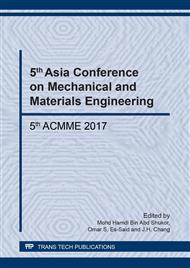p.177
p.182
p.187
p.193
p.199
p.207
p.213
p.219
p.225
Surface Modification Effects on Microstructure and Mechanical Properties of Bio-Titanium Alloys
Abstract:
Ti-6Al-7Nb (Ti67) alloy has recently been developed to replace the commercial Ti6Al4V (Ti64) alloy because of the reported cytoxicity of vanadium. Surface modification by thermal oxidation is used to enhance the hardness and wear resistance of such titanium alloys. Since Ti67 alloy contains Nb as β phase stabilizer instead of V in Ti64, it is expected to behave differently upon processing by thermal oxidation. Therefore, it is of interest to compare the response of the two alloys to thermal oxidation in terms of hardness and wear resistance. Forged and cast samples were used to study the influence of the microstructure on the surface properties after oxidation. The forged samples with their equiaxed microstructure showed a well developed sub-surface hard layer (α-case) compared to the cast structure for the two alloys. The thickness of this case in Ti64 after oxidation at (900-1100 °C) was greater than in Ti67. This resulted in higher wear resistance of the Ti64 alloy relative to Ti67. These results are worth considering when designing implants for joints replacement.
Info:
Periodical:
Pages:
199-204
Citation:
Online since:
November 2017
Authors:
Price:
Сopyright:
© 2017 Trans Tech Publications Ltd. All Rights Reserved
Share:
Citation:


